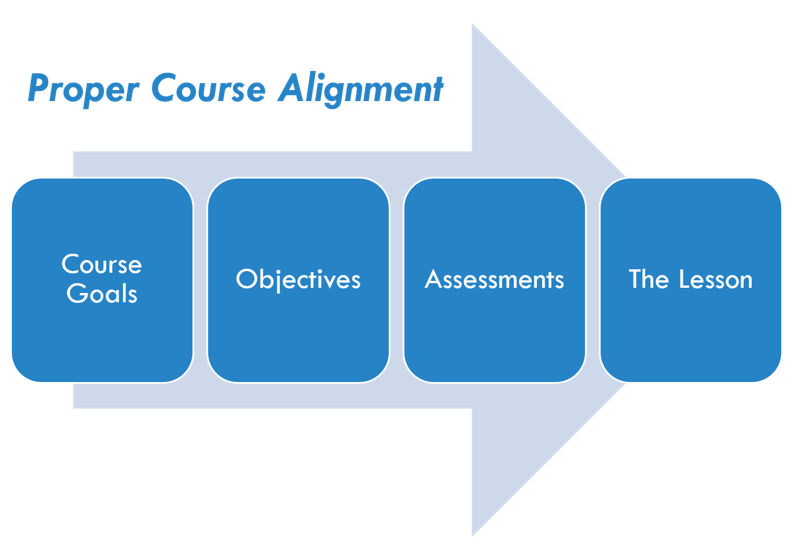Developing Effective Courses Using Adaptive Learning Begins with Proper Alignment
Published by: WCET | 9/13/2017
Tags: Practice
Published by: WCET | 9/13/2017
Tags: Practice
Similar to the birth of eLearning in the 1990s, the rush to implement adaptive learning has led to the development of poorly designed courses that are not properly aligned and fail to effectively implement the principles of multimedia learning. As a result, many institutions often proclaim their use of adaptive learning as a failure. Much of their disappointment with the initial results can be directly linked to the design of the course itself. One of the wonderfully unique strengths of using adaptive learning to deliver courses at the university level is the ability of the tool to illuminate gaps in the course design.
Oftentimes, universities make a swift decision to incorporate adaptive learning into a course, program, or department (and sometimes across departments when prompted by grants and other financial incentives) as one way to address their student success strategic initiatives. While adaptive learning is an excellent tool for improving student success across a university campus and its feeder system, little attention is usually given to the role of the faculty when redesigning courses for use in such a platform. Additionally, there is a gross underestimate of the time required to design and develop courses that are both aligned and adhere to the principles of multimedia learning. In an effort to most effectively take advantage of the power that lies in the use of a strong adaptive learning platform, faculty should be involved in the process from day one and the use of instructional designers should be considered a valuable use of resources.
Regardless of the delivery modality, poorly designed courses impact student success. It is past time we pay more attention to this critical issue as we now have tools that can provide support to students on a one to one basis. Attention to the development of a properly aligned course is imperative for student success. More often than not, however, most faculty completely ignore or lack knowledge of what proper alignment is, how to use it, and why it is important.
Proper alignment means there is a direct connection, or correlation, between the course goals, the objectives, the assessments, and lessons. Proper alignment ensures that students learn what you intend for them to learn and are able to perform the tasks you expect them to be able to perform. One of the most effective ways to ensure proper alignment of a course is through the use of the backward design model. In this model, faculty begin with the end in mind and design the actual lesson last.

Faculty should ask themselves, “What do students need to know and be able to do by the end of this course?” Whatever it is that students should know and be able to do at the end of the course is the stick by which all other decisions about the course and its design should be measured. If an objective, assessment, or lesson does not contribute to that ultimate goal(s) of the course, it should not be included.
Faculty and other course developers should have a very narrow focus for each course they develop and always ask if each assessment and each lesson will help their students achieve the goal(s) for their course. Additionally, faculty should know that less is usually more in education. There should be no more than one, maybe two, overall goals for any particular course. Much thought should be given to exactly what the goal of each course is or should be.
When deciding to move a course into an adapted learning platform, it is crucial that the course has a clearly defined goal and that you are able to define what success means, especially if your university is working to meet student success initiatives. Defining success helps the adapted platform partner better meet your needs by providing yo u the most important data and identifying possible gaps in the course and curriculum.
Anytime you have a large goal, you should have smaller goals that help you reach that larger goal. I like to explain to the students in my teacher education courses that a course goal and its objectives are like a ladder. The course goal sits at the top of the ladder and each rung on the ladder is an objective that students need to master in order to reach that course goal.
Another critical component of effective learning objectives is that they must be SMART (Specific, Measurable, Achievable, Relevant, and Time sensitive). This can be quite challenging for faculty to grasp. Each learning objective set must meet the SMART criteria to increase the likelihood of student success in any course.
When designing a course for delivery using an adaptive learning platform, you must map out the objectives and determine if these objectives must be learned in a particular order such as is typically the case with math courses as they follow a more linear path – you must be able to add and subtract before you can multiply and divide. Here, you are beginning to tap into the power of the adapted platform to highly personalize the course to each student’s needs based upon their incoming knowledge.
Hopefully by now, you have clearly identified your course goal and the learning objectives that will be needed to help students reach that goal. Now you are ready to think about how you will know if students reach the goal and how you will measure their progress toward meeting that goal along the way. My professional opinion is that effectively assessing students continuously is the backbone to learning.
The days of giving a midterm and final should be over in higher education although I am clearly aware that it is not. This is clearly a training issue. Unless you have been trained as an educator, you may not have ever been taught how to teach. Unfortunately, just because you are an expert in your field does not mean you can do an effective job of teaching others. This is where the university must take a stand and begin requiring that faculty receive professional development and training around pedagogy/andragogy.
To determine how much students are learning throughout the course, the use of formative assessments are key. Here, you are assessing for learning. In an adapted course, these assessments allow you to provide detailed feedback and adjust the lesson for students on an individual and dynamic basis. Effective feedback is critical to increasing learning and it is essential that the feedback is timely. In an adapted course, feedback is immediate regardless of the time of day or night. No teacher can or ever will be capable of doing this without the assistance of a digital tool, such as an adaptive platform.
In my experience, getting faculty to understand the importance of and commitment to the development of effective assessments is the most challenging part of designing a course to be delivered using adaptive learning. While not new, variablized questions – assessment questions with multiple correct and incorrect answers – is an excellent assessment type to maximize the power of adaptive learning. While it takes a little time to get the hang of, the use of 5 variablized questions can allow an adapted platform to produce over 100 different versions of those questions! When each question is properly tagged to each objective, strong evidence for student success can be clearly identified. This is where the use of adaptive learning gets exciting! There’s nothing like seeing the results from your hard work developing a properly aligned course from top to bottom.
I teach students that the last component they need to develop in the backward design of their course is the actual lesson. After you know the goal, the objectives needed to reach that goal, and how you will assess students’ progress toward that goal, you are now ready to design the lesson. To me, this is the easiest part of the design process. By now the picture is clear and you are best able to develop a lesson that is not only aligned to the goal and objectives of the course but also ensure that you will teach in such a way that will best prepare students for the ways in which you will assess them.
At the end of the day, I am either helping my students succeed or helping them to fail. Too often in academia, we like to pass the buck off to the students. However, this practice is not fair unless we can ensure that our courses are properly aligned and that we are asking students to complete activities and assessments that will help them move up the ladder to reach the ultimate goal of the course.
The use of adaptive learning can allow faculty to design lessons to ensure that all learners are capable of succeeding by properly aligning their courses. However, as you now might be able to more clearly see, the development of effective courses, rather delivered face-to-face, in a hybrid setting, or in an online format, will require the involvement of faculty and, in many cases, the use of instructional designers. Additionally, faculty must be supported with course releases or other appropriate support needed to develop effective courses that can increases student success.
While the use of proper alignment is a critical aspect of course design, the proper use of multimedia principles are also needed. Catch my next blog post for an overview of the multimedia principles and how they are used to design effective courses.
Niki Bray
Instructor & Instructional Designer
School of Health Studies
Physical Education Teacher Education (PETE)
The University of Memphis
Former WCET Fellow on Adaptive Learning
n.bray@memphis.edu
Target image credit: http://hopbeinc.blogspot.com/2012/09/setting-smart-goals.html
Learn more about WCET!

1 reply on “Developing Effective Courses Using Adaptive Learning Begins with Proper Alignment”
[…] way course content is presented to learners, including those delivered using technology. In my last post, we discussed how to design courses using the Backward Design method, a process that ensures proper […]